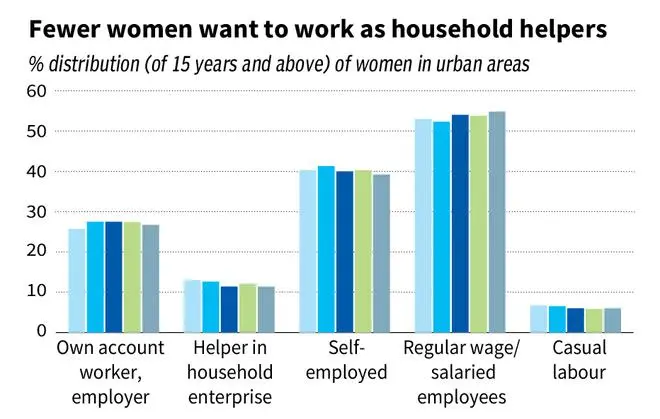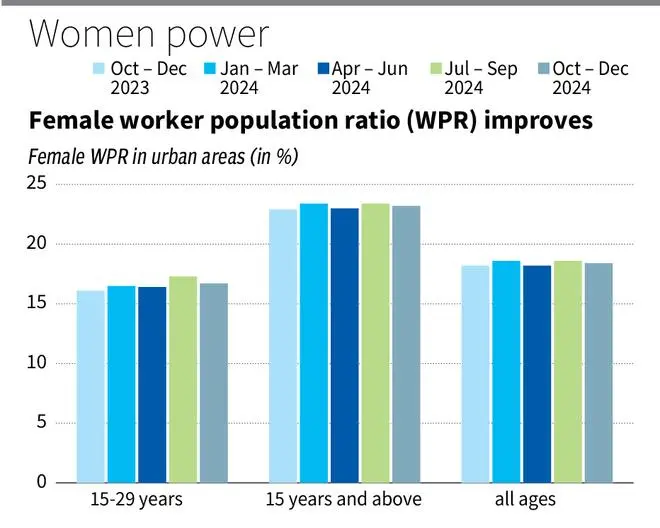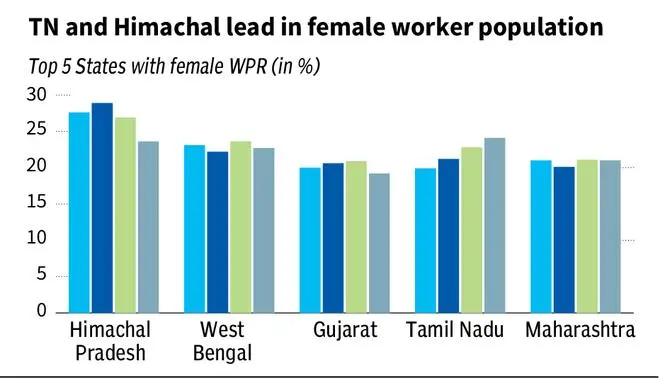The latest Periodic Labour Force Survey (PLFS) data highlights a notable shift in women’s employment. More women are moving into formal, salaried jobs and away from informal and household work.
The proportion of urban women in regular wage or salaried employment rose from 53 per cent to 54.8 per cent between the quarter ending December 2023 and the corresponding quarter of 2024. This shift towards formalisation came alongside a decline in the share of casual labour declining from 6.7 per cent to 6 per cent. The percentage of women working as helpers in household enterprises also dropped from 13 per cent to 11.4 per cent over the year. The proportion of self-employed women, too, recorded a slight decline from 40.3 per cent to 39.2 per cent.

businessline’s analysis of the Quarterly Bulletin of the PLFS by Ministry of Statistics and Programme Implementation data reflects a modest but stable rise in urban female workforce participation.
The Worker Population Ratio (WPR) for urban women aged 15 years and above increased from 22.9 per cent in the October-December 2023 quarter to 23.2 per cent a year later. While quarterly fluctuations were minimal, the proportion remained consistently above 23 per cent, indicating a sustained trend in women’s employment.

According to Vidya Mahambare, Union Bank Chair Professor of Economics and Director at Great Lakes Institute of Management, Chennai, “This steady rise in salaried employment suggests formal job opportunities for women are growing, especially in urbanised and industrialised States…Better education among women, delayed marriage and low fertility are structural shifts that improve women’s ability and willingness to participate in the labour market.”
TN gains more
Tamil Nadu’s WPR for women rose sharply from 19.4 per cent in October-December 2023 to 24.1 per cent a year later, the highest gain among the top five States.
In contrast, States like Himachal Pradesh (23.6 per cent) and West Bengal (22.7 per cent), while maintaining higher female WPRs overall, showed either a dip or slower growth in the same period.

Experts note that Tamil Nadu’s success reflects not just economic opportunity but also social and policy shifts. Labour law reforms, such as allowing night shifts for women, employer-provided transport and better public infrastructure, help support this upward trend.
Across all age groups, the WPR for urban women remained resilient in 2024, with notable improvement in the 15-29 age group, climbing 16.1 per cent to 16.7 per cent. A potential signal that younger women are entering the workforce earlier and more steadily.
As India’s urban employment landscape continues to evolve, this shift towards formalisation in female employment may represent a durable transformation, provided it is supported by gender-sensitive urban planning, accessible care infrastructure, and policies promoting equitable domestic responsibilities.
The author is an intern with businessline





